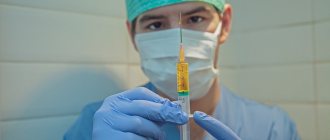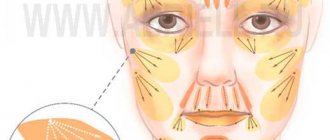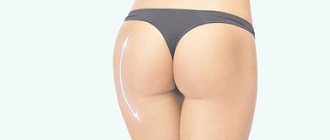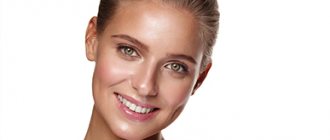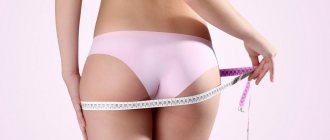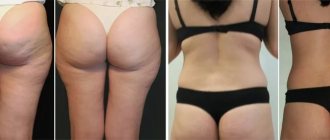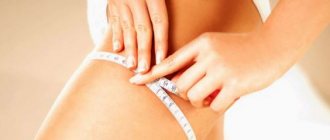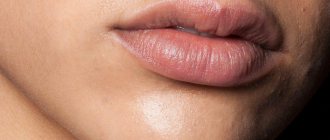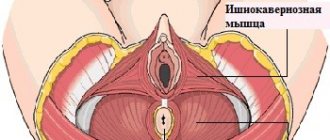It’s a rare social media user who hasn’t yet seen demotivators demonstrating the difference between girls who squat with a barbell and those who don’t. Naive young ladies get the impression that working out in the gym is guaranteed to give them the coveted Brazilian butt - round and convex, without a subgluteal fold, but with a charming depression in the lumbosacral region. Demotivators do not say anything about the fact that the shape of the buttocks depends on the structure of the muscles and is difficult to correct with exercises. It is especially difficult to achieve noticeable results for girls whose gluteal muscles contain more white fibers than red ones. Meanwhile, it is quite possible to become the happy owner of a firm and seductive butt that attracts the male gaze like a magnet. With the help of modern plastic surgery.
Famous for their “fifth point,” J. Lo or Kim Kardashian haunt not only the stronger half of humanity – men, but also the fairer sex.
But, as with everything, sometimes excesses happen in our lives and, as they say, there is no limit to “perfection.” And then we can see these “suitcases” of fat.
So, where is the line between aesthetics, beauty, harmony and excess? To understand this, we found several articles in the literature devoted to the study of “factors” of beauty and harmony of the buttocks and lower body as a whole. Below is a diagram that briefly reflects the main criteria for aesthetically attractive or “ideal” buttocks.
Aesthetically ideal buttocks:
1) (a) When measuring the circumference of the waist at the narrowest point and the hips at the widest point, the WHR ratio is close to 0.7.
2) The upper internal border of the buttocks is clearly defined and starts from the upper point of the intergluteal groove, continues along a semicircular line upward along the crest of the posterior iliac spine and reaches the sacral dimples.
3) In well-formed buttocks with a small subcutaneous fat layer, the sacral triangle (the so-called V-zone) is clearly defined, which further emphasizes the upper border of the buttocks.
4) The muscles of the buttocks are shaped like a football with almost equal volumes in all four quadrants (the lower quadrants are slightly wider than the upper ones).
5) The subgluteal folds begin from the distal (lower) point of the intergluteal groove and diverge in an arcuate manner outward at an angle of 45° relative to the vertical line of the inner thighs. As a result, a diamond-shaped “window” is formed in this zone (in English literature – “diamond” shape).
6) (b) The subgluteal groove is short and does not reach the midline of the posterior thigh;
7) (c) The transition of the back/buttocks in the lateral projection has an S-shape, the maximum point of projection of the buttocks is in its central zone.
Knowledge of at least these basic signs of beautiful buttocks will help readers further understand and appreciate the essence of the very process of this difficult operation called fat grafting of the buttocks, as a direction of “liposculpture” or, as the world-famous “buttock specialist” Dr. S. Mendieta wrote, “ The Art of Gluteal Sculpting."
PREOPERATIVE EVALUATION OR INDICATIONS FOR BUTTOCK LIPOFULLING
According to Dr. Mendieta's research, based on viewing more than 1000 photographs of the buttocks and adjacent areas of the body, 4 main types of buttock structure can be distinguished:
Before planning buttock fat grafting, it is very important to evaluate and classify the initial parameters. So, what do we have for our patient: First of all, we determine the type of figure - “Rectangle”, which is closest to the android in terms of metabolism and fat accumulation. The chest, hips and waist volumes are almost the same. The waist is wide, not clearly defined. The difference between the waist circumference and the hip circumference is 15 cm. The body is strong, the sporting background shows, the legs are slender. The curve of the hips is not pronounced, the legs are slender, and the buttocks are flat. The waist circumference is 74 cm, and the hips are 92 cm. The difference between the waist circumference and the hip circumference is 18 cm, and their ratio is 0.8 (ideally, as we already know, this ratio should be 0.68 - 0.7) .
As a rule, with this body type, there is a tendency to be overweight, and when gaining weight, fatty tissue is deposited mainly in the flanks, back and abdomen, “smoothing” and disguising the waist, visually making the figure even more like a rectangle. In addition, the pronounced asymmetry of the right and left halves of the body is noteworthy: the left leg seems shorter, the left shoulder is lower, the pelvis tilts to the left, the waist contour seems flatter, and on the right it seems more “steep”. It seems that even in a calm position without tension, the patient stands with a slight tilt to the left.
Now comes the fun part. The patient has a rectangular buttock shape, to determine which it is necessary to mark 3 points on the photo (symmetrically on both sides):
- The most prominent point on the upper-lateral part of the iliac wing is point A.
- The maximum projection of the outer thigh is point B.
- The projection of the middle of the lateral surface of the buttocks is point C.
If you connect these points, the type of frame or shape of the buttocks is easily determined - in our case, the closest is rectangular, with a noticeable asymmetry of the right and left halves.
In the area of point C (in the area of the supratrochaneteric fossa), our patient has a pronounced deficit of soft tissues, more on the right. True depression at point C, by definition, is caused precisely by a deficiency of soft tissues. Before the operation, I assumed exactly this. But, as it turned out during the operation, the depression was false, i.e. largely due to excess fat deposits in the flank area. After careful liposuction of this area, the shape of the buttocks became A-shaped, and the tissue depression in the area of the C point became slight. It took only 150 ml of fat to fill it.
In the area of the presacral triangle, there is a significant deposition of adipose tissue, which, combined with insufficient volume of the buttocks, creates the impression of flattened buttocks that do not have clear boundaries.
At the same time, the volume of soft tissues in the buttock is distributed unevenly, the maximum amount is in the 3rd and 4th quadrants, and in sector 1 there is a tissue deficiency, which is even more pronounced in sector 2. In aesthetically attractive buttocks, the volume of soft tissues should be approximately the same in all quadrants.
The ratio of the height of the sacrum and the intergluteal groove is initially 1:1 (in aesthetically attractive buttocks - 1:3).
Just like the ratio of the height of the buttock to the length of the intergluteal groove is initially approximately 1:1 (it looks more aesthetically pleasing when this ratio is 2:1). Therefore, in our patient, the buttocks seem not only flat, but also short and low.
The profile photographs clearly show that the maximum projection (greatest convexity) of our patient’s buttocks is located in the lower third. While for aesthetic appeal, maximum filling in the central zone (in the projection of the pubic bone) with an even transition to the upper and lower parts is important. As a result, a regular, beautiful S-shaped line will be formed along the contour of the lower back and buttocks. In our case, S is a line that is not clear, not regular, and flattened.
J - the zone of transition of the inner lower part of the buttocks into the thigh is about 90o (according to aesthetic standards, it should be sharp, i.e. about 45o).
In the photo from the front, the beginning of ptosis can already be clearly seen - the gluteal fold crosses the midline of the thigh. We see the absence of ptosis when the gluteal fold does not reach this line.
Ptosis of the buttocks in this case is confirmed in the profile photo: the femoral-gluteal angle already exceeds 45o (normal) and is already tending to become more obtuse, exceeding 60o. In my opinion, this is due to a lack of soft tissue in the upper and central part of the buttocks.
Planning for lipofilling surgery of the buttocks
The patient’s height is 159 cm, weight is 57 kg, age is 33 years.
Photographing of the patient before the operation is performed in standard positions: front with lowered and raised arms in front and behind, half-profile on 2 sides, profile on 2 sides and in the same angles with markings applied.
Taking into account the peculiarities of the anatomical structure of the figure, in order to completely change its contours, the first stage requires careful liposuction, primarily of the back, flanks, abdomen and, of course, the sacral area. It is very important to “carve” the sacred triangle, lower back and waist, thereby forming a smoother transition into the hips and visually “lengthening” the hips. Liposuction performed in this way, “eliminating” the excess, will already significantly change the outline of the figure for the better.
The second stage, to radically change the shape of the buttocks, 600 - 800 ml of adipose tissue must be injected into each buttock - lipofilling. Since I was not confident that I would “collect” a sufficient amount of fat, as well as to improve the contour of the legs, the areas of the inner surface of the upper third of the thighs and knees were additionally outlined.
One of the peculiarities is significant fat pads in the area of the ribs - therefore, on the preoperative markings, you see these zones. In the photo, the areas marked with a cross will be subjected to liposuction (donor), and the shaded areas (recipient) will be filled with the resulting fatty tissue.
What threads are used to lift the buttocks?
It's time to figure out which threads are best to use for the procedure. Experts distinguish several types:
1. Brazilian.
Dissolve within 1 year. Inserted using cannulas. It is worth saying that they are not in demand in leading Russian cosmetic centers;
2. Mesothreads.
You need to be extremely careful with them. If you have visible problems, these threads should be discarded. They do not have notches, so it will not be possible to secure and lift the fabric. But they can perfectly correct the shape of the buttocks. They create a certain framework and trigger natural processes. Thanks to them, cellulite disappears and the skin becomes elastic. Often girls pay attention to these threads, because their price is quite affordable (750 rubles apiece);
3. Ligatures.
These threads do not dissolve. They are embedded deep in the subcutaneous tissue. Judging by the reviews of experts, the risks of an allergic reaction and rejection are minimized. The threads are made of noble metal (gold). They are considered obsolete material and are also not in great demand;
4. Polypropylene.
Used often. Their advantage is small notches. The fabric can be fixed in the required position. The threads do not dissolve, the effect lasts for 2 years. After this, correction will be needed. The threads can be tightened and the buttocks returned to their previous shape. For their manufacture, materials are used that are used to stitch wounds in surgery. They do not cause rejection or allergic reactions;
5. Absorbable.
Made from polylactic acid. There are notches on the threads. They hold fabrics well. But the peculiarity of the threads is that within 8 months they completely dissolve, turning into lactic acid. It promotes active lymphatic drainage and collagen production. Thanks to this, a powerful lifting effect is achieved. This type of thread is the most popular. But their cost is high (from 5,000 rubles per piece).
The selection of threads should be carried out by a cosmetologist. It is important not only to evaluate their cost, but also the tasks they cope with.
New shape of buttocks
Considering the small height, in my opinion, too much volume is not needed, and the round shape can visually shorten the legs and “weight” the figure. Therefore, it was decided to create an A-shape, athletic, oval buttocks. First of all, increase the height of the buttocks, fill the depression zones in the area of the trochanters and increase the projection in the upper and central parts; naturally, the maximum volume must be placed in the center.
Once again I would like to draw your attention to the fact that the main goal is to improve the contour of the lower half and the entire body as a whole, i.e. what is called liposculpture. Therefore, first we remove “everything unnecessary” using fat aspiration, and only then we begin to work on creating the shape and volume of the buttocks.
How to prepare for a consultation
We ask you to carefully evaluate your figure in the buttock area and formulate your expectations from the operation, so that you can then discuss the possibility of realizing them with the doctor. Prepare all your questions and come for a butt lift consultation. If you want, you can invite a friend or other loved one with you who can support you and make the consultation more comfortable for you. During the consultation, we will ask you to tell us about the presence of certain health problems, about taking medications, and about allergic reactions.
Preoperative examination and preparation for lipofilling of the buttocks
Ultrasound of the vessels of the lower extremities was added to the standard tests before surgery: a comprehensive clinical blood test, coagulogram, infections, FLG, ECG with interpretation. The test results are satisfactory. Since a large volume of surgery was planned, which, as a rule, is accompanied by blood loss, close attention was paid to red blood indicators: hemoglobin, red blood cell content. In such cases, we always perform autohemotherapy: on the eve or in the morning of the day of surgery, 400–600 ml of blood is taken from the patient. Next, the patient is transfused with the required amount of blood substitutes and other “useful” solutions that temporarily replenish blood loss. As a result, during the operation, blood loss will be less due to its preliminary “dilute” with solutions.
Immediately after the end of the surgical intervention, their own blood is transfused back, which allows patients to recover faster in the postoperative period. In the morning, a clinical blood test is required to monitor hemoglobin levels and red blood cell counts. Of course, it will be 40 - 50 units lower. This is due not only to blood loss, but also to a significant amount of transfused solutions, both during and after the operation. Within 2-3 days after surgery, excess fluid is eliminated from the body naturally, and hemoglobin rises by 20-30 units. All these manipulations require the installation of a special catheter in the central vein (subclavian, jugular, femoral, etc.), which also takes some time and is not a very pleasant, but quite tolerable procedure for the patient.
Preparing for surgery
After an in-person or correspondence consultation, in the absence of primary contraindications, the patient is determined on the date of the operation and receives a list of laboratory tests that must be completed no earlier than 10 days before the operation. Based on the test results, if there are no contraindications, the date is confirmed. A list of laboratory tests can be found here.
Lipofilling of the buttocks
Lipofilling of the buttocks
Lipofilling of the buttocks
Lipofilling of the buttocks
Lipofilling of the buttocks
Anesthesia (Narcosis) for buttock enlargement
Always combined: intubation, intravenous and epidural. This combination reduces the number of administered drugs, and, consequently, the load on the patient’s body, facilitates recovery from anesthesia, and the administration of painkillers through the epidural catheter allows for prolonged anesthesia after surgery (2-3 days - if necessary) and patient comfort in the early postoperative period .
SECOND DAY AFTER BUTTOCK ENLARGEMENT SURGERY
The postoperative period of fatgrafting of the buttocks is characterized by severe edematous syndrome (in the first week after surgery, weight may increase by 5–7 kg compared to preoperative), an abundance of hematomas, which can appear from the first to 5 days, as well as symptoms associated with blood loss: dizziness , weakness, hypotension.
As a rule, all these symptoms begin to appear from the end of the first day after surgery, and then quickly increase over 3–5 days, then a plateau is observed - symptoms at the same level for 5–7 days and only then gradually they go away, sliding from top to bottom. But not completely - too significant trauma to the blood and lymphatic vessels. After 2 - 3 weeks, the main swelling goes away, but some of it remains. A "chatter" begins - sometimes more, sometimes less. Depends on physical activity, fatigue, phase of the cycle, nutritional characteristics, etc. The edema syndrome will finally leave the body after 3 months, but there have been cases when it partially persisted up to 6 months.
Patients stay in the plastic surgery clinic for 2–3 days, and then are discharged, but are monitored for at least another 7–14 days. To speed up recovery after surgery, reduce the number of hematomas and edema syndrome, rubber graduates are installed during surgery in the area of the sacrum and lower abdomen, which can last up to 3-4 days, which, of course, requires daily dressings under sterile conditions.
To speed up recovery after fat grafting of the buttocks, in addition to active infusion therapy, our clinic uses a complex of rehabilitation procedures, including microcurrent therapy, pressotherapy, a polarized light lamp and magnets with an alternating and stable field in combination with homeopathic ampoules. Traumeel S ointment is applied to the fatgrafting area, and Lyoton Gel to the liposuction areas several times a day. We always start these comfortable physiotherapeutic procedures from the first day after surgery; cosmetologists and rehabilitation specialists perform them during dressings once, and if necessary, 2 times a day. This significantly alleviates the patient’s condition, reduces discomfort and speeds up healing.
Before and after buttock augmentation
6 DAYS POST OPERATION
9 DAYS POST OPERATION
12 DAYS POST OPERATION
IN COMPRESSION UNDERWEAR
RECOMMENDATIONS AFTER LIPOFILLING OF THE BUTTOCKS
- It is imperative to wear compression underwear, it saves and protects, especially in the first 2-3 weeks after surgery.
- It is necessary to eliminate pressure on the fat grafting area. You cannot lie or sit on your buttocks, and when point C is filled, on your side for 1 month.
- You can only sit using “fishing chairs” or special “pillows” that allow you to sit on the back of your thighs, while your buttocks are suspended.
- It is necessary to limit physical activity, heavy lifting, and not engage in sports for 3 months.
- It is necessary to maintain a stable weight and never go on a diet. The transplanted fat will not withstand stress and will melt first.
- You cannot sunbathe, visit a solarium, or travel to countries with hot climates for 3 months.
- Hot baths, saunas, steam baths, and massages are contraindicated for all patients.
Technique for performing a buttock lift with threads
A buttock lift with threads is not a complicated procedure. In total it takes no more than 1 hour. Several stages can be distinguished:
1. Consultation with a cosmetologist. After you have decided on the choice of clinic and doctor, a visual examination and identification of the range of problems is required. The specialist must assess the fat layer, skin type, and find out whether the patient has any contraindications;
2. Determination of areas for insertion of threads. For this purpose, special marks are made on the buttocks;
3. Anesthesia. Local anesthesia is used. Typically, a cream is used;
4. Insertion of threads. The areas are treated with an antiseptic, and a thread is inserted using a cannula. After this, it is pulled up and secured; if there is excess material left, it is cut off. A patch is attached to the puncture sites and ice is applied to relieve swelling.
A minimum of 8 threads are used per buttock. If the situation is advanced, the quantity can reach 25 pieces.
